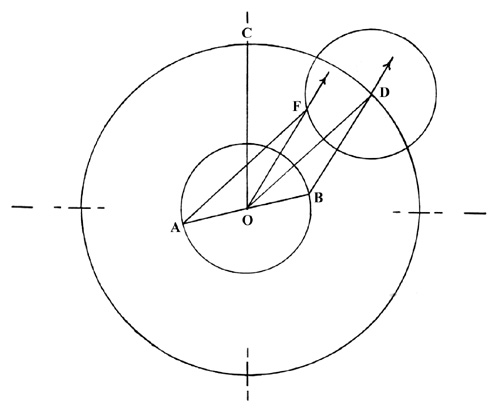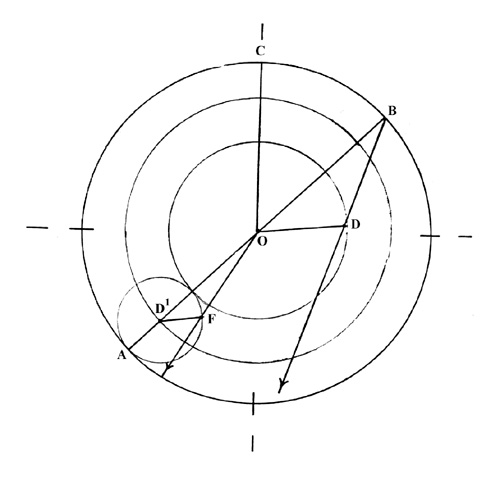The Geometrical equivalence of the geostatic and heliostatic systems for representing apparent motions is often not sufficiently emphasized, though it is easily demonstrated.
Superior Planets (Figure 1). In the Copernican hypothesis, O is the sun, B the earth–which revolves through any angle COB–and D is a planet which in the same period revolves through angle COD. The apparent position of the planet is on line BD. Transposing this to Ptolemaic terms, O is the fixed earth, A the sun, D the center of the planet’s epicycle. If F is the position of the planet in the epicycle, then DF:DO = BO:DO. Moreover, AOB is a straight line, and~FDO =~COB -~COD = ~ BOD. These relations follow from the form of the constants used by Ptolemy and Copernicus respectively. Thus the apparent position of the planet is given as before, since line FO is parallel to BD, and triangles AFO and BDO are identical.

Figure 1
Inferior Planets (Figure 2). The situation here is slightly different. The Copernican representation is similar to that above, with the sun at 0, earth at B, planet at D, and the position given by line BD. In the Ptolemaic scheme the central earth is at 0, the sun at A, and the center of the planet’s epicycle is on radius AO. Values for radii of the deferent and epicycle may be chosen so that D’F:D’O = DO:BO, provided D’F + D’O<AO = BO. As before, these relations follow from the form of the constants adopted by Ptolemy and Copernicus. For the same reason the velocity of rotation from F about D’ is such that~OD’F =cCOD -cCOB =cBOD. Hence, as with the superior planets, FO and BD are para]lel, and the maximum elongation of the planet from the sun is the same on either hypothesis. Note that since any geometrical complexity added to one representation is reflected by a corresponding one in the other, the apparent positions of the planets are always the same in either hypothesis. For the inferior planets, Venus and Mercury, however, triangles OD’F, BOD, are similar but not identical.

Figure 2
These planets cannot appear in the Ptolemaic scheme (as they do in the Copernican system) on the superior side of the sun. In the Copernican system Venus should appear in quadrature with the sun at maximum elongation, as later observed by Galileo. A minor geometrical adjustment to the Ptolemaic scheme made it equivalent to the Copernican (astronomically speaking) by centering the epicycles of Venus and Mercury on the sun, drawing them about A. Compare the planetary models of Heraclides of Pontus, Tycho Brahe, and Longomontanus.
Adapted from A. Rupert Hall, TheScientificRevolution, Appendix B.